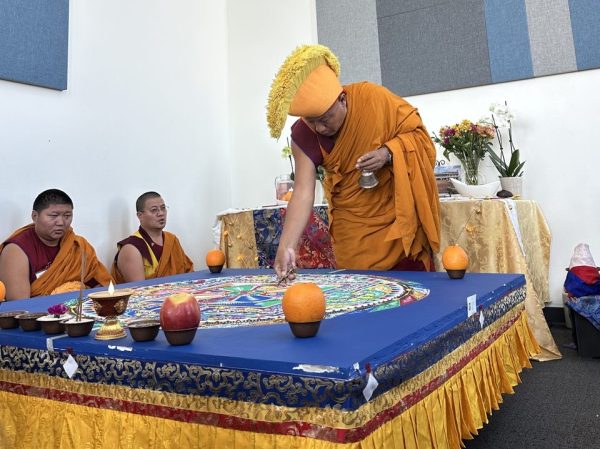
Over the span of five days, monks from the Drepung Gomang Monastery worked together to meticulously create a sand mandala on the fifth floor of the Howard-Tilton Memorial Library. On Saturday morning, several swipes of a paintbrush erased it.
Ancient Tibetan mantras filled the room as the six visiting monks chanted the sutra in synchrony on either side of a finished mandala. Their combined voices were low and melodic, echoing centuries of Buddhist wisdom and devotion. One of the monks flipped through the individual beads of his prayer necklace. As each chant ended, the lead monk guided a transition into another.
Members of the Tulane and greater New Orleans community gathered in silence to pay their respects to the Buddhist altar at the front of the room and listen to the flow of syllables from the monks’ lips. The sound reverberated through the room’s four walls, oscillating in volume as their voices rose and fell in unison. The rhythmic repetition of the chants created a meditative atmosphere, pulling its audience into a state of deep mental clarity.
“I thought it was really impressive that only six people could make such a powerful chant,” Ben Pethe, a sophomore who had his first encounter with Tibetan Buddhism through the event, said. “It felt like I was in a real temple, instead of the Howard-Tilton Memorial Library.”
Unfolding over several days, the sand mandala grew gradually in increasing complexity. Visitors saw the monks using a metal funnel called a chakpur, rubbing its ridges with a metal rod to create a gentle buzzing sound while dispersing the colored sand to replicate a pattern committed to memory. A meditative process, the finished mandala stood a testament to the monks’ skill and dedication.
“The first day, it’s maybe the size of my hand. They had the foundation, and I was like, wow, this is already amazing,” sophomore Doruk Toydemir said. “It’s otherworldly. Just to see how much time they spend on that every day … and then they ruined it.”
With a bell in one hand and a vajra — a ritual object translated as “Thunderbolt Way” for enlightenment — in another, the lead monk began the dismantling ritual, as the others again chanted the sutra. The vajra sliced through the center of the mandala several times, and strokes of a paintbrush swept the colored sand into a blended pile. Through the visual metaphor of sand, the monks emphasized the Buddhist doctrine of impermanence, teaching the audience a lesson in nonattachment.
“I don’t know exactly what I was supposed to be feeling throughout the ceremony,” Toydemir said. “It was very calming, but … uncomfortable, because it was so loud.” He said the part that struck him most was the ringing of the bell.
Fan Zhang, professor of art history and Asian studies, recalled the introduction of the concept of religion, a Western-constructed topic, in Asia. “Japanese people had a huge trouble translating the term religion,” Zhang said. “There’s a huge debate of how this term in English can be translated into an Asian language.”
Where religion in the Western sphere has largely been associated with Christianity, Zhang said it is imperative for students to think about Tibetan Buddhism through an insider cultural lens.
Zhang also invited the monks for a guest talk directly with her students.
Geshe Chaeden is one of over 2,000 monks at the Drepung Gomang Monastery. He spoke about his personal experiences and daily life within the monastery, which typically involves morning study sessions, simple meals, prayer rituals called puja and classes and scripture debates
“I think the value of the opportunity is to provide students the first-hand knowledge of what the religion is for the people in Tibet, for people in Asia,” Zhang said. Sophomore Dylan Hsu said it was interesting to learn more about how Buddhism was practiced among the lay people of Tibet, in comparison to the monks.
Zhang said Tibetan Buddhism is especially unique due to the region’s isolation from the rest of the Asian continent and lack of colonization. Over time, religious practices have also become modernized in different variations from the traditional understandings. With the experience, Zhang said she hopes to dissolve the Western barriers which classify Tibetan Buddhism as “exotic,” in both religious and cultural aspects.
“To watch the monks, to talk to them, I got a very different experience on their beliefs,” Toydemir said.
“Asian studies is still kind of on the periphery of the intellectual landscape on campus,” said Zhang. She said she hoped that by offering the class, and having the event, the whole field of Asian studies could gain more attention from Tulane students and the local community.



